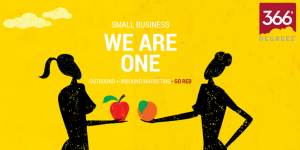Take your marketing strategy to the next level by combining the audience building of inbound marketing and the immediate returns of outbound.
If you’ve been paying even an iota of attention to advertising trends this past decade, you know inbound marketing is the poster boy for modern promotion.
Where our marketing forefathers relied primarily on ad campaigns displayed through popular media outlets, businesses across the world are turning their efforts towards the inexpensive slow-burn alternative of inbound marketing.
But just because the business world may be experiencing an enormous shift in marketing capabilities, that doesn’t mean the old ways should be left behind entirely.
In fact, incorporating inbound as well as outbound components into your marketing strategy might be the best way to secure leads and create evangelist customers.
Outbound Marketing vs. Inbound Marketing
Inbound marketing and outbound marketing, as you may have guessed from the names alone, are completely opposite in their fundamental philosophy on bringing in leads.
To fully understand how incorporating both marketing strategies into your campaigns can help your company thrive in today’s marketplace, it’s critical to know the ins and outs of each.
Outbound Marketing: Where It All Began
Outbound marketing for many is seen as “traditional” marketing. Magazine ads, telemarketing campaigns, billboards, and email blasts are just a few of the ways modern marketing incorporates outbound into their advertising strategies. In fact, outbound marketing is what people imagine when they think of advertising in general.
Its fundamental goal is to make potential customers aware of the product or service they offer. In a way, outbound marketing is directly paying for your attention, whether by sneaking a few pop up ads into your favorite website or by investing in a full-page ad in your local newspaper.
The benefit of an outbound marketing strategy is the ease of which an ROI can be determined from specific campaigns. If, for instance, a business launches a new ad in a popular magazine, calculating the return on investment is a pretty simple process. Not only that, but the effects of an outbound marketing strategy can be seen relatively quickly.
Inbound Marketing: The Future of Advertising
With all the popups and banner ads consumers are subjected to every day, the typical web surfer has gotten better than ever at ignoring advertisements. In fact, 63% of internet users are estimated to ignore online advertising entirely.
So, what do you do when your winning strategies of the past start to fall flat? You adapt. That’s where inbound marketing comes in. Rather than buying your consumer’s time by paying for ads, inbound marketers aim to earn it through the creation of valuable content.
With this kind of content, inbound marketers are able to build a relationship of trust and authority with their audience. The result is the business becomes a source of reliable information in its field and, as such, is the first place people go for a solution to their problem. And with a proper nurturing process sprinkled with more informative content, that lead is converted into a customer.
Blog posts, articles, white papers, and case studies are some examples of content that are at an inbound marketer’s disposal. Social media presences through platforms like Facebook, Twitter, Instagram, and Linkedin are a core part of inbound as they help develop a wider and more engaged audience.
Although inbound marketing produces three times as many leads as outbound while costing 62% less, making it perfect for small businesses, one of the drawbacks is the fact that an accurate ROI may be difficult to establish as most of this content is distributed for free and attribution is difficult to set up.
Additionally, a solely inbound-based strategy will likely take time to develop a lead into an actual customer due to its foremost goal of education rather than selling.
A Diversified Strategy is an Effective Marketing Strategy
Many small businesses are asking the same question: which strategy should I go with, inbound or outbound?
While there is no perfect answer since each business is unique, one of the best strategies you can implement is a hybrid of the two.
For example, almost half of the top B2B businesses’ marketing budgets were spent on inbound marketing. Not 100%, not even 75%, but around half. The takeaway from this is that the best of the best don’t put all their eggs in one marketing basket.
Like a successful investment portfolio, the safest and most rewarding strategy is a diversified one.
Prioritize a Marketing Automation Service That Uses Both Outbound and Inbound
When it comes to choosing a Marketing Automation Platform (MAP), your best bet is to confirm first that your CRM integrates and accommodates lead and engagement history seamlessly. Some of the most popular (MAP) choices out there include HubSpot, Pardot, and Marketo, but can end up costing a small fortune to execute and require 6 to 8 week implementations with heavy workflow and set up.
That’s why 366 Degrees is perfect service for small to medium businesses. It offers comparable service to the big names at a portion of the cost and implementation and set-up is immediate. Connections to leading CRM, Video Marketing, Lead and Data Intelligence services are standard within 366 Degrees.
Take advantage of a sophisticated Marketing Automation and Sales Enablement platform built specifically for the SMB market, create landing pages that convert, and develop email, social and video marketing campaigns that generate lifelong customers.
Don’t forget about 366 Degrees’ seamless integration with leading CRM, Sales & Marketing cloud services like Salesforce.com, Microsoft, Nimble, Vidyard, Datanyze and leading Social Brands.
Let 366 Degrees Take Your Marketing to the Next Level
If you want to gain control of your marketing strategy with a marketing automation service that leverages current CRM investments + takes advantage of both inbound and outbound marketing, Try 366 Degrees!